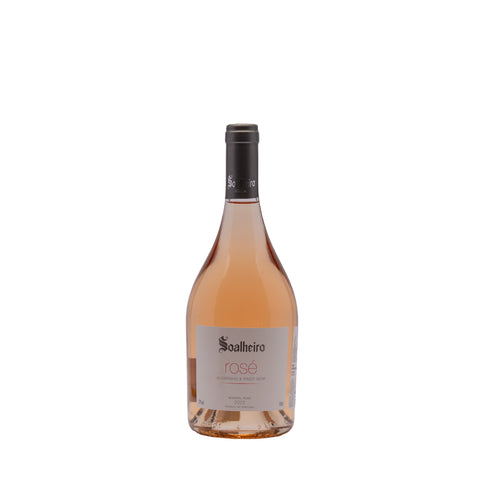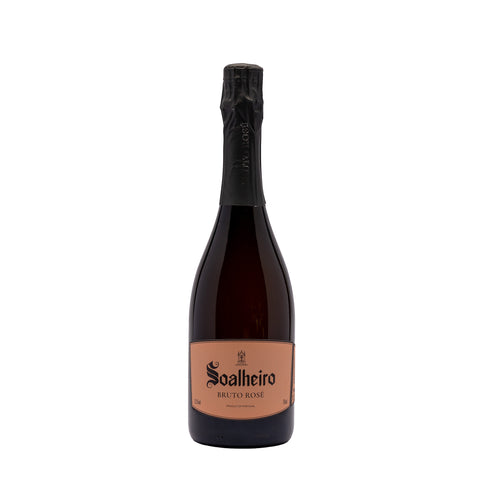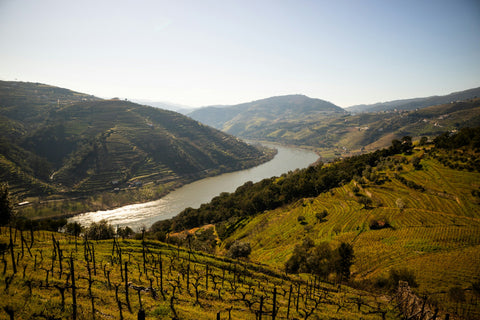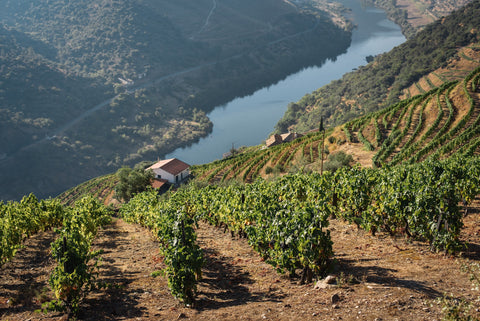
The Minho, located in the north of Portugal, is a region steeped in history where stunning nature, ancient traditions and unique flavours meet. Famous for its Vinho Verde (green wine), Minho is much more than a wine region: with its green hills, charming villages and rich cultural heritage, it offers an unforgettable experience for lovers of wine, history and Portuguese cuisine.

The cradle of Vinho Verde
Vinho Verde, or “green wine,” is one of Portugal’s wine gems, and Minho is its exclusive terroir. Contrary to what its name might suggest, Vinho Verde is not a green wine, but a young, fresh and slightly sparkling wine, ideal for hot summer days. It can be white, red or rosé, although white is the most common. With notes of citrus, green apples and sometimes a slight effervescence, it is particularly appreciated for its lightness and refreshing acidity.
The Minho climate, with its mild summers and abundant rainfall, plays a key role in the production of this wine. Typical grape varieties such as Alvarinho, Loureiro and Arinto provide their unique characteristics.
A green setting
Minho is often described as “the green region of Portugal”, and for good reason; its landscapes are a mix of rolling hills, espaliered vineyards, crystal-clear rivers, and beautiful forests. The region is crossed by the Minho River, which marks the natural border with Spain, and by other rivers such as the Lima and the Cávado.

|
The Minho River | © Eduardo Vales, 2017, Flickr
|
The development of Minho: a journey through time
The Minho region has been inhabited for thousands of years. Since ancient times, the Celts occupied the hills and built castros and fortified villages, some of which still exist today, such as in Citânia de Briteiros. The Minho was also crossed by Roman roads connecting the Iberian Peninsula, evidence of the region's strategic importance in trade and communication.
In the Middle Ages, Minho played a crucial role in the formation of Portugal as a nation. It was in Guimarães, often called "the city where Portugal was born", that the first Portuguese king, Afonso Henriques, established his power in the 12th century. Today, the city is a UNESCO World Heritage Site - medieval fortresses, churches and monasteries, such as the Monastery of São Martinho de Tibães, are symbols of a region influential in the consolidation of the Portuguese kingdom.

| The Church of Nossa Senhora da Consolação and the Largo República do Brasil Boulevard | © porto-north-portugal.com, 2024 |
The city of Braga, nicknamed the "Portuguese Rome", with its numerous churches, its Sé de Braga Cathedral and the Bom Jesus do Monte sanctuary, famous for its monumental staircase and breathtaking views, became an important spiritual and cultural centre during this period.

| Bom Jesus do Monte Sanctuary | © Daniel Majak, 2021, www.finallylost.com |
In the 16th and 17th centuries, viticulture took off in the Minho. The region became the cradle of Vinho Verde, whose production was favoured by the humid climate and fertile soils. Agricultural techniques developed, and the espalier vineyards, still visible today, began to shape the landscape. At the same time, small towns and villages prospered thanks to local trade and the wealth of agricultural land.
The contemporary era: a region in transition
In the 20th century, the Minho underwent major transformations with the modernization of infrastructure and the improvement of means of transport. Roads, railways and bridges, such as the famous Eiffel Bridge in Viana do Castelo, facilitated economic and cultural exchanges. However, the region remained faithful to its traditions, particularly in the areas of crafts, gastronomy and religious festivals, such as the famous Romeria de Nossa Senhora d'Agonia in Viana do Castelo.
Today, the Minho is a popular destination for its natural, cultural and wine heritage. The development of tourism has allowed the restoration of many historical sites and the promotion of local traditions. Local quintas welcome visitors for Vinho Verde tastings, while cultural events attract travelers from all over the world.
Local gastronomy
Minho is a region where gastronomy reflects the richness of its land. Its traditional dishes are often hearty and obviously accompanied by a good Vinho Verde. Among the typical dishes of the region we can find:
- Arroz de Sarrabulho : rice simmered with blood and pork, a comforting specialty for cold days.
- Bacalhau à Minhota : a local recipe of fried cod served with caramelized onions and potatoes.
- Papas de Sarrabulho : a kind of thick stew made with pork blood and spices.
And finally, let's not forget regional sweets such as:
- Tortas de Guimarães : a delicate pastry made with filo pastry and sweet pumpkin.
- Clarinhas de Fão : a sweet treat made with sweet dough and pumpkin.
Must-see places to visit
Minho is full of fascinating places to explore. In this article, we have selected a list of places that appeal to both locals and travelers looking for adventure and authenticity.
- Ponte de Lima: This charming village, often considered one of the oldest in Portugal, is famous for its Roman bridge and traditional festivals. The Ponte de Lima market is perfect for discovering local crafts and products.
- Peneda-Gerês National Park: This park, the only one in Portugal, is home to enormous biodiversity, with spectacular waterfalls, isolated villages and rich wildlife - a must-see for nature lovers.
- Monção and Melgaço: These two villages are the strongholds of the Alvarinho grape variety. Here you can visit local quintas (we recommend a visit to the Quinta de Soalheiro) to taste some of the best white wines in the region.
- Viana do Castelo: Located on the coast, this maritime city is known for its Santa Luzia sanctuary, which offers panoramic views of the ocean and the Lima River.
- Arcos de Valdevez: A picturesque village is ideal for a peaceful walk along the Vez River, surrounded by green landscapes.
- Valença : a fortified city with well-preserved ramparts, perfect for an immersion in medieval history.

|
A small waterfall in the Peneda-Gerês National Park
|
An authentic and enriching journey
Minho, with its thousand-year-old history, natural beauty and preserved traditions, has evolved without losing its authenticity. Each era has left a unique mark on this fascinating region and today, the region embodies a harmonious balance between its rich past and its modern development.
The Vinho Verde, the green landscapes, the cultural heritage and the local gastronomy are all reasons to discover this unique region.
So, pack your bags and go explore Minho - a treasure of Portugal that is just waiting for you!






Comments (0)
There are no comments for this article. Be the first one to leave a message!